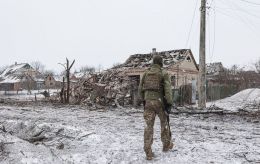Russia uses nearly 90 guided aerial bombs against Ukraine today. Zelenskyy promises tangible response
 Photo: Volodymyr Zelenskyy, President of Ukraine (Vitalii Nosach, RBC-Ukraine)
Photo: Volodymyr Zelenskyy, President of Ukraine (Vitalii Nosach, RBC-Ukraine)
Since the beginning of the day, Russian forces have used nearly 90 guided aerial bombs to strike Ukraine. Ukrainian defenders will respond to the enemy, according to the evening address of Ukrainian President Volodymyr Zelenskyy.
He reminded that rescue operations are ongoing in Sumy following a Russian airstrike on a care home for the elderly. At the time of the strike, nearly 300 people were in the building—over 200 patients and 60 staff members. Evacuation is ongoing, and rescuers are clearing the debris. At least one person has been confirmed dead.
The head of state emphasized that Russia could not have been unaware that the care home was intended for the elderly and was not a military base or target.
"Just today—so far—Russian forces have already used nearly 90 guided aerial bombs. Against our cities, against Ukrainian positions. We will definitely respond to the Russian army for this terror. We will respond significantly," Zelenskyy stated.
Strikes with guided aerial bombs (KABs)
Russian guided aerial bombs pose a significant problem for Ukraine, as there is currently no way to intercept them. The only method to combat such weapons is to destroy the carriers.
This is why Ukraine is asking its Western allies to allow the use of long-range missiles for strikes on Russian territory, including airfields.
President Zelenskyy has repeatedly urged the US and other allies to lift restrictions on strikes within Russia, but this has yet to happen.
Frontline regions regularly suffer from KAB strikes. For instance, according to Volodymyr Artyukh, head of the Sumy Regional Military Administration, the enemy launched 753 KABs on the region in August alone.

